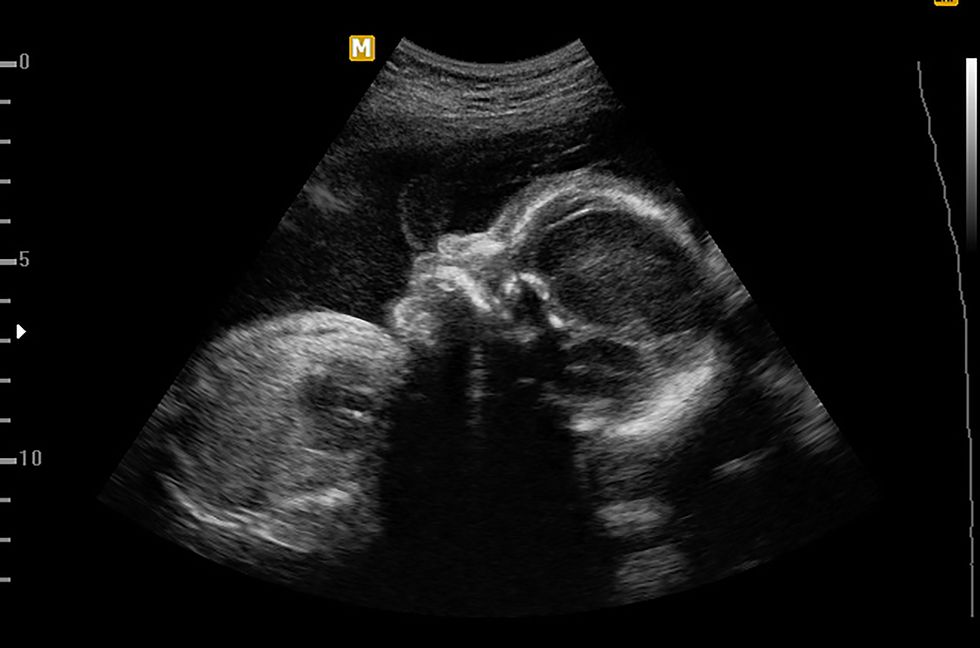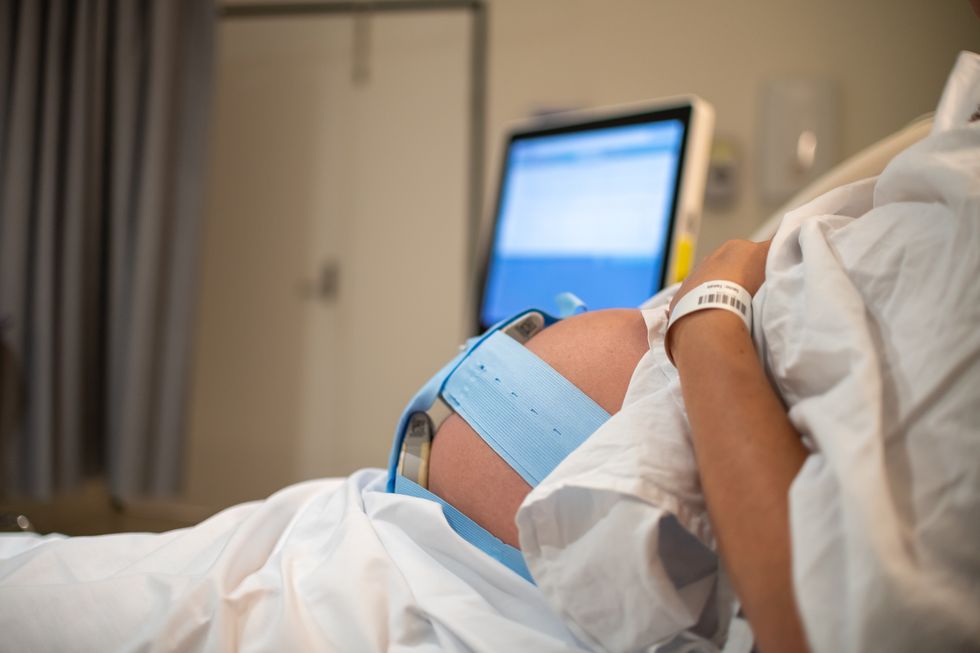Rinat Dray’s due date passed uneventfully. She had two young boys at home and was excited to meet the third. Feeling contractions about a week later, Dray went to Staten Island University Hospital (SIUH) on July 25, 2011, but was disappointed to learn she was only two centimeters dilated.
When her labor slowed, she decided to leave the hospital and return when she was further along. Her doctor strongly encouraged her to get a C-section because she was a week overdue, her labor was not progressing, and she was in pain. He also advised her against leaving, citing the risk of uterine rupture, a rare but life-threatening complication, and other risks to her health and to the fetus. Dray had given birth to both of her sons via C-section; with her third child, she was committed to attempting a vaginal birth after C-section (VBAC). So she checked out against medical advice, later explaining that she’d believed she’d have a better chance of having a VBAC if she came to the hospital closer to delivery than in her previous births.
She went home and, the next day, returned to the hospital with stronger contractions. What unfolded over the course of the day is the subject of a lawsuit, pending since 2014, that has drawn the involvement of the New York State Attorney General’s office, which filed an amicus brief, and may have implications for pregnant patients across the state. Dray’s case is finally scheduled to go to trial this year. As this high-stakes medical drama has played out in courts over the past 10 years, it’s raised dramatic questions for pregnant patients: Can doctors force women to have a C-section without their consent? How does the concept of fetal rights impact what happens in the delivery room? And how can pregnant patients expect to be treated, medically, ethically, and legally, in post-Dobbs America?
While oft-cited World Health Organization (WHO) figures suggest the optimal rate for C-sections is somewhere between 10 and 15 percent of births, in the U.S., 32.1 percent of births in 2021 were via C-sections. These procedures can be lifesaving and are an essential tool in many healthy births, but the soaring rate of such procedures—including a 53 percent increase between 1996 and 2007 in the U.S.—has some experts concerned about overuse.
In the U.S., most patients who initially give birth by C-section have their subsequent children the same way, but not always. And when it comes to VBACs, assessing risk can feel like a no-win situation: Having a successful VBAC has been shown to have fewer complications than a planned repeat C-section, according to the Mayo Clinic, but attempting a VBAC and then ending up with a C-section is associated with more complications, including uterine rupture.
It’s not that Dray was entirely unwilling to consent to another C-section, she tells me, it’s just that she desperately wanted to avoid an unnecessary one. And given that many doctors don’t recommend VBACs after three C-sections, this may have represented her last chance to deliver vaginally. Over time, she had come to believe that she hadn’t been given enough time to labor during the first two births at two other hospitals, leaving her to bear a large personal cost. “Eight months after the [first C-section], I was still having trouble walking, holding my baby, and doing basic housework,” she explained in an affidavit.
Pregnant with her third child, Dray hoped, prayed—and researched. She reviewed the American College of Obstetricians and Gynecologists (ACOG) guidelines on VBACs and studied up on complication rates. Dray and her husband, both Orthodox Jews, wanted “as many children as God would give us,” so the risk of complications that could increase with each subsequent C-section was particularly concerning for her. She also wanted to experience vaginal birth and give her third child the benefits of vaginal delivery: faster recovery and the ability to bond with the baby immediately after birth.
She found Metropolitan OB/GYN Associates, a provider that she says was initially willing to let her try for a VBAC—although as her pregnancy progressed, her doctors there recommended she have a scheduled C-section because she had a history of gestational diabetes, fetal decelerations (or temporary drops in heart rate), and arrest of dilation, which she declined. (Dray disputes some of the descriptions of her earlier births.) When Dray returned to the hospital on July 26, she was around 2.5 centimeters dilated. Leonid Gorelik, MD, the only doctor in the Metropolitan trio Dray hadn’t had an appointment with, was on duty. (Lawyers currently representing Metropolitan OB/GYN and Gorelik did not respond to multiple requests for comment.)
Dray was having contractions every few minutes and was in severe pain. Gorelik reiterated things his practice members had previously told her, explaining the possible “risk of [uterine] rupture, fetal death, and maternal death as complications” of not getting a C-section. (A C-section, which is major abdominal surgery, also carries risks.) Gorelick testified that he told Dray that in order to avoid these potential complications, she should proceed with a C-section. Gorelik then gave Dray two options—stay for an epidural and a C-section, or check out of the hospital against medical advice.
According an affidavit she filed in her lawsuit, when Dray told Gorelick that she was considering going back home again to labor more there, Gorelik “became belligerent.” Gorelick allegedly told her: “Okay, go home and rupture your uterus at home, and if you leave, you shouldn’t come back.” (In his deposition, Gorelik denied ever making these statements.)
She didn’t like how Gorelik was treating her, she’d later explain in an affidavit, but her contractions were coming on strong and she was in a lot of pain. Gorelik “seemed to cool down,” she recalled, offering her an epidural for her pain and suggesting she could try for a vaginal birth. Gorelik testified that he saw her acceptance of the epidural as “a positive development,” and while he explained to her that a vaginal delivery was still possible, he “assumed she was understanding the situation that she was in, the gravity of the situation and the risks that it potentially involved” to both her and her fetus.
“No surgical procedure should be undertaken without a patient’s consent, period,” says Jeffrey L. Ecker, MD, a high-risk obstetrician with decades of experience. “It doesn’t matter whether or not they’re pregnant.” But pregnancy does create a unique situation, as the fetus is only accessible through the pregnant patient’s body. “Almost always, what patients want is exactly what we want—healthy patients and a healthy baby. So when someone seems to be choosing something that doesn’t align with that, our obligation is not to force, but to understand and work to convince,” he says.
Stakes are high during a birth, and patients may decline or delay a medical intervention, even when told it’s necessary, because they believe doing so is in the best interest of the fetus. In situations where there is disagreement over a medically recommended course of action, Ecker says that usually agreement can be reached. “But in the end, if we truly can’t, the right thing is to prioritize an individual’s autonomy and allow them to decide what should be done to their body,” he says. That doesn’t always mean it’s easy.
Ob-gyns carry some of the highest malpractice premiums in medicine. In 2014, the broader practice of obstetrics and gynecology was described by a paper published in the American Journal of Obstetrics & Gynecology as “extremely vulnerable to external medico-legal pressures.” A 2009 study published in the Medical Care journal noted that C-sections “are not risk free, but they are widely perceived to reduce risks of the kinds of catastrophic birth injuries that fuel expensive litigation.”
Doctors might find themselves struggling to balance a pregnant patient’s autonomy and wishes with a desire to act with beneficence toward a fetus, Ecker adds. They want to secure optimal outcomes and avoid worst-case scenarios, like having to deliver a newborn’s body to the hospital morgue instead of sending a baby home with its family.
According to a joint opinion issued by the ACOG Committee on Ethics and the American Academy of Pediatrics (AAP) Committee on Bioethics, any intervention on a pregnant patient requires her explicit consent, and a woman’s right to informed refusal “must be respected fully.” Despite the considerations of how interventions may benefit both the mother and the fetus, “even the strongest evidence for fetal benefit would not be sufficient ethically to ever override a pregnant woman’s decision to forgo fetal treatment.”
Still, in some cases, when unable to convince their patients to agree to a treatment, doctors have used pressure, bullying, force, or the courts to achieve compliance. Some women have alleged that their ob-gyns have threatened to call the police if they didn’t check themselves into the hospital for a recommended C-section, or they’ve issued ultimatums such as a call to child protective services, or the possibility of a court order, to get them to submit.
In forced C-section cases, the threat to involve child protective services is so common that one researcher told the legal publication Sage Journals she couldn’t think of “a situation where that wasn’t part of the coercion.” Another law review article describes a 2010 case where a woman claimed that after she didn’t immediately consent to a C-section, she was still denied immediate access to her newborn, even after eventually agreeing to a C-section. She claimed that the hospital had called child protective services, describing her as unfit to parent because of the conflict over how she’d give birth, and she was subjected to a months-long investigation before the agency dismissed her case.
Bodily integrity and informed consent are hallmarks of medical ethics, but when it comes to pregnant patients, not all doctors always agree or act in accordance. One 2018 study found that two-thirds of labor and delivery nurses and birth doulas surveyed in the U.S. and Canada “occasionally or often” observed providers doing procedures to pregnant patients without giving the woman a choice or time to consider or, much less frequently, engaging “in procedures explicitly against the wishes of the woman.”
In a 2012 case, a lawsuit was filed against an ob-gyn in New Jersey for allegedly bullying a patient into a C-section. “I think there’s a judgment that, no matter what, as long as your baby is healthy, you shouldn’t be dissatisfied by your birth experience,” the woman told Yahoo! News. “It’s not the surgery that affected my life. It’s the blatant disregard for my humanity, and my ability to make decisions for myself and for my kids.”
In court, the ob-gyn said she disagreed with the ACOG position “that the desire of the mother has to supersede the fetus. I have two patients. I have an obligation now toward the baby. I have to speak for the baby because that is my second patient.” (The case reportedly settled out of court on undisclosed terms.)
Dray’s water broke at around 10:40 A.M. According to hospital records, there was meconium—the first stool—which is usually passed after birth but can be a sign of distress when it happens in utero (that it was “thick” troubled the doctors). Still, Dray was ecstatic to learn she’d reached five to six centimeters dilation. “Don’t be so excited, this isn’t going to be natural [childbirth],” Dray alleges Gorelik told her, stating that he didn’t “have all day” for her. (In his deposition, Gorelick denied saying this.)
An examination at 12:55 P.M. revealed Dray’s dilation hadn’t changed in two hours, but the fetus was “starting to develop late [fetal] decelerations, which indicate a decrease in oxygen supply through the placenta,” according to Gorelik’s deposition. “I told her this is another reason why a C-section is the reasonable next step,” Gorelik said. “We’re running out of options because at this point not only is it affecting the mother, but it’s also affecting the baby.”
According to Dray, Gorelik’s attempts to get her to agree to a C-section became increasingly hostile as the day wore on. According to Gorelik, he listed all the facts and possible complications supporting a C-section, but still Dray “flat-out refused” to agree to the procedure.
“I just couldn’t sit and watch the baby be under the stress and do nothing,” Gorelik explained during his deposition, expressing concern the fetus would not survive. So he sought out James Ducey, MD, who was the director of Obstetrics and Maternal-Fetal Medicine at SIUH and chairman of the hospital ethics committee. Ducey showed up at the labor ward, reviewed Dray’s medical records, spoke to Gorelik, and then spoke to Dray at Gorelik’s behest. “I told her that she needed to have C-section, and she said she wanted to have a vaginal birth and she just wanted to have more time. I told her that it was highly, highly unlikely that she could have a natural birth,” Ducey recalled. “She understood that there was a risk to her baby in not doing the C-section.”
Around 2 P.M., Gorelik came in, and according to Dray, he put on gloves as if to do an exam, but then said he’d only do one if she signed the C-section consent form. (Gorelik was not asked about this during his deposition.) As Dray remembers it, after she declined to sign the form, Gorelik said he was going to get a court order and threatened her with the possibility of contacting child protective services. (While being deposed, Gorelik was read quotes attributed to him by Dray in her deposition, and said he had “absolutely not” said those things and also denied that he’d ever talk to a patient like that.) Dray says her contractions and labor had picked up since he last examined her an hour earlier, but he removed his gloves without examining her and left.
While Dray’s recollection differs significantly from those of her doctors, and a nurse who was present said “no one was crazy or acting out,” they weren’t the only ones in the room. Dray had hired a doula named Shayna Eliav after learning a doula can be helpful in supporting a patient attempting a VBAC. Later that day, shocked by what she’d seen, Eliav says she went to a convenience store down the block, bought a notebook, and wrote down her recollections.
She documented Dray being told early in the day that if she left not to come back, and that as the day progressed, Gorelik dismissed signs of progress, refusing to examine her unless she signed the C-section consent form, and “threatened to file to judicial review board to have court-ordered C-section if no progress was made.”
As Eliav explained during her deposition, Gorelik “was going in and out of the room applying more and more pressure, threatening that she could be forced for a court order, that she could lose her baby, she could lose custody, that similar cases had happened.” He was “intimidating her and increasingly in cruel ways,” she said, adding, “there were just a lot of threats being waged from Dr. Gorelik to Rinat.”
Conflicts over pregnant patients’ rights can be traced through the legal history of court-ordered C-sections. The first appellate court ruling that took a stance against forced C-sections concerns Angela Carder, a woman who, while pregnant in 1987, learned her previous cancer had returned and was diagnosed as terminal. Carder had initially agreed to treatments that could have possibly extended her life long enough for her fetus to survive outside of the womb, but as her health deteriorated and it became increasingly unlikely that either she or the fetus would survive a C-section, she chose to forego the surgery and receive pain medications to remain comfortable until her death. Despite her wishes, the hospital sought an emergency judgment on what to do because the fetus was past viability. Her husband, parents, doctor, and lawyer opposed a C-section. At first, Carder seemed to acquiesce, but later repeatedly told her doctor, “I don’t want it done.” The court ordered it anyway, on behalf of the fetus.
Carder survived the operation, but died two days later, with the C-section listed as a contributing factor. Her baby died within two and a half hours after birth. In the aftermath, Carder’s family fought to have the order vacated. In 1990, the District of Columbia Court of Appeals offered a stunning rebuke; all eight judges ruled to vacate the judgment that had ordered the C-section and found the earlier judgments incorrectly placed the state’s interest in a viable fetus above a patient’s autonomy.
The ruling was heralded as a victory for rights in pregnancy, asserting that in “virtually all cases the question of what is to be done is to be decided by the patient—the pregnant woman—on behalf of herself and the fetus.” The ruling drew from McFall v. Shimp, a 1978 Pennsylvania case wherein a man sued his cousin for a lifesaving bone marrow transplant. In that case, the judge declined to order the man to submit to the transplant that would save his cousin: “For our law to compel the defendant to submit to an intrusion of his body would change every concept and principle upon which our society is founded.”
As it applied to pregnancy, the Carder judgment concluded, “a fetus cannot have rights in this respect superior to those of a person who has already been born.” A Washington state judge made a similar point in a different case wherein he declined to order a C-section, writing, “I would not have the right to require the woman to donate an organ to one of her other children, if that child were dying.”
Three years later, in another C-section case, an Illinois appellate court was even more clear in denouncing court-ordered interventions on behalf of a viable fetus, finding “the potential impact upon the fetus is not legally relevant.” Still, other courts have ruled in favor of forced C-sections, at times citing Roe’s viability framework to argue that the state has the right to intervene on behalf of a viable fetus.
As law professor Lisa Ikemoto wrote upon examining a court case involving a forced C-section, “Judges listen to doctors because medicine is regarded as a source of authority whereas individual women are regarded as a source of trouble.” But doctors aren’t always right, risk is complex, and medicine is imperfect. There have been reports of women who’ve gone into hiding to avoid a court-ordered C-section or who’ve fled to other hospitals more willing to honor their wishes, giving birth to healthy babies vaginally. Some cases in which judges have declined to order C-sections despite dire predictions have also resulted in safe vaginal deliveries.
Kimberly Mutcherson, a professor of law at Rutgers Law School, notes a concerning erasure of the autonomy and bodily integrity of the women at the center of forced C-section cases. In one particular ruling, “the judge who ordered the C-section [basically] says, ‘The only thing that stood between you, this baby and life outside of the womb was a surgeon’s scalpel.’ It’s not just a surgeon’s scalpel, it’s a person’s body!” That person was Ayesha Madyun. “I never dreamed they could do that,” Madyun told the ABA Journal in 1989, three years after a court-ordered C-section performed against her will: “I felt they were dominating me. I felt I was being raped.”
Obstetricians and lawyers who identify as “pro-life” are more likely to believe in court-ordered C-sections than those who don’t identify as such, according to a 2007 study. Fifty to approximately 70 percent of “pro-life” respondents rated themselves as “highly likely” to use a court order across a variety of scenarios. Even in a situation where the pregnant woman has a medical condition that would make the C-section 10 times more deadly to her than the national average patient, nearly 30 percent of pro-life respondents were “highly likely” to seek a court order—willing to risk the pregnant patient’s life in order to potentially save her fetus.
Dobbs is already impacting access to safe termination of pregnancies and treatment of pregnancy-related complications. Lawmakers across the country are now proposing C-sections or vaginal delivery as the only treatment options for life-threatening pregnancies, in order to increase the likelihood of fetal survival. As Jessica Valenti author of the Abortion, Everyday newsletter, wrote in the New York Times, “instead of having minutes-long abortions, women will be forced by the state to endure major surgeries or traumatic vaginal deliveries, even if that seriously affects their physical and mental health.”
More broadly, the criminalization of behaviors and decisions during pregnancy and childbirth is on the rise in the U.S. Fetal protection laws and maternal conduct laws are increasingly used to criminalize all sorts of behavior during pregnancy and childbirth. As reported in a 2023 study by the nonprofit Pregnancy Justice, some states have expanded the definition of child abuse to include treatment of embryos and fetuses, and these laws have been used against hundreds of pregnant women struggling with addiction. Pregnancy Justice, which has filed an amicus brief in support of Dray, found 413 cases between 1973 and 2005 involving arrests of or forced interventions and detentions of pregnant women; between 2006 and the Dobbs ruling, they found more than three times as many cases in half as many years.
Women have been arrested after having miscarriages or stillbirths, then charged with murder. In 2004, a Utah woman was initially charged with first-degree murder for declining a C-section doctors said was essential; when she eventually consented to the procedure days later, one of her twins was stillborn. She was jailed, but eventually took a plea deal where the murder charge was dropped in return for her guilty plea on two counts of child endangerment.
In other cases, child protective services have gained custody of a fetus, or a pregnant patient has been detained until giving birth, in order to assure a certain course of treatment. Several states have statutes that impede the implementation of advance directives or next-of-kin requests if a brain-dead patient is pregnant. In 2013, Marlise Munoz, a brain-dead woman in Texas, was forced to stay on life support against her family’s wishes because she was 14 weeks pregnant. Two months later, a judge finally ruled against the hospital’s efforts to keep her on life support until a C-section could be performed, concluding the relevant law didn’t apply to a dead woman.
Michele Goodwin, author of Policing the Womb, expects Dobbs and the expansion of fetal rights will bring increased control, coercion, and criminalization throughout pregnancy and childbirth, noting this is something vulnerable populations experienced under Roe. (Forced C-sections and other court-ordered medical interventions are more likely to happen to pregnant patients who are poor or women of color, or for whom English is not their first language.) “One concern that I have is that folks are still in a kind of myopia, thinking each day, ‘It can’t get worse,’” Goodwin says. “Whereas they need to understand, ‘Oh, it gets much worse.’ ”
Around 2:15 P.M., Dray’s fetal decelerations worsened, according to Gorelik. After speaking to Gorelick, Ducey spoke with Dray and explained that a vaginal birth was highly unlikely, but Dray still would not consent to a C-section. Ducey mentioned to Dray that SIUH had a policy that, by its own terms, dealt with “refusals by a pregnant woman…of medical treatment in the hospital judged to offer a reasonable possibility of significant benefit to her viable fetus.” (Dray alleges that she was not informed of the hospital’s policy prior to being admitted.)
Ducey then called the hospital attorney, and they discussed the options while reading through a hospital policy governing maternal refusal. The policy, first reported in the Guardian’s U.S. online news site, allowed doctors to override a competent pregnant patient’s refusal of medical treatment if the treatment carries “a reasonable possibility of significant benefit” for the fetus that “outweigh[s] the possible risks to the woman.” (Lawyers currently representing Ducey and the hospital did not respond to multiple requests for comment.) The attorney asked if there was time for a court order, a psych evaluation, or a bioethics review. “I told him that there was not a minute that could go by without additional risk to the baby,” Ducey testified in his deposition.
At 2:30 P.M., Ducey made a note in Dray’s medical records: “The woman has decisional capacity,” he wrote, meaning she was competent. “I have decided to override her refusal to have a C-section.” Per court docs, he said he then “informed Mrs. Dray of the decision in order to prevent imminent and serious harm to her fetus.” At 2:36 P.M., Dray was wheeled into the operating room.
“I kept saying that I believe my baby is fine and I want to have more time and that I want to have a natural childbirth,” Dray testified. “I kept begging them that they should do that—give me more time,” until the last moment when Ducey told her she had to get on the operating table and she complied. The consent form remained unsigned.
At 2:48 P.M., Gorelik began the surgery and Ducey scrubbed in around 20 minutes later once he learned the baby still wasn’t out. According to Ducey’s testimony, a minute after scrubbing in, he perforated Dray’s bladder with a scalpel. She remembers hearing someone scream, “Urologist!” Twenty-seven minutes after the C-section began, Dray’s third son was born.
Her baby, born healthy, was moved to the hospital nursery. Dray’s C-section and bladder repair lasted over three hours; she spent five days in the hospital. She was distraught, angry, and devastated. “Physically, I felt broken,” she says. She went home with a catheter, a newborn, and a fear of ever giving birth again.
“I’m going to do everything in my power, [so] that he’s not going to do it to others,” Dray reports telling her husband after her forced C-section. She felt that her doctor’s fear of lawsuits had adversely impacted her care. In her affidavit, Dray alleges that when she asked for more time to labor, she was allegedly told “my license is more important than you” by Gorelik. (He wasn’t asked about this during his deposition.)
In 2014, Dray filed a lawsuit against SIUH, Gorelik, Ducey, and Metropolitan OB/GYN. The court dismissed many of her claims, but what remains of her lawsuit going to trial this year is a claim of medical malpractice related to whether it was necessary to perform the C-section instead of a vaginal delivery. The dismissal of Dray’s other claims are still the subject of appeal and last fall, the New York AG filed an amicus brief in support of Dray.
Beyond Dray’s case, the AG’s office insists that one aspect of the lower court’s prior ruling—that the state has an interest in a viable, full-term fetus—has dangerous implications for pregnant patients more broadly. If such a decision were to become precedent, it could potentially allow doctors to override the wishes of pregnant patients, based on “the paternalistic assumption that pregnant people are less capable than others of making medical and practical decisions that are best for themselves and for their pregnancies, and reflects and reinforces archaic gender stereotypes,” according to the AG.
In response to a New York Department of Health investigation resulting from Dray’s story, in 2018 SIUH changed its “managing maternal refusal” policy, subsequently requiring doctors to abide by the patient’s wishes.
Dray’s malpractice case still faces challenges, including how jurors might perceive her. “I’ve told this story about Rinat to a zillion people,” says her lawyer, Michael Bast. “Half the people say, ‘The doctors are so horrible. They’re so wrong. I can’t believe this.’ And the other half say, ‘The woman is so horrible. I can’t believe this.’ And everyone has an immediate gut reaction.”
In Dray’s lawsuit, experts for each side have reached startlingly different conclusions about what happened the day her third son was born. In a report filed in support of the defendants, James Quirk, MD, a retired ob-gyn with expertise in maternal-fetal medicine, wrote that the C-section was “entirely indicated” and “squarely performed” in alignment with contemporary medical standards, and that the bladder laceration wasn’t medical malpractice, but a “recognized and accepted complication,” one that’s more likely in an emergency C-section like Dray’s.
But Katharine Morrison, MD, also an ob-gyn, submitted a report in support of Dray with very different conclusions. In her opinion, Dray’s doctors “misinterpreted the [readings of the fetal heart rate]; prematurely declared an arrest of labor; failed to take well-established standard methods to ensure fetal well-being; and failed to take steps to minimize the risks of injury during the surgery.”
Perhaps most shocking of all is another conclusion of Morrison’s. According to her review of the case, “The panic expressed by the doctors was more a reflection of anger toward their recalcitrant patient, than actual danger reflected in the fetal heart strips.…If they had allowed the labor to continue, there was a substantial chance that she could have delivered vaginally, thus avoiding the physical and emotional injuries which resulted from the forced C-section.”
What happened still feels like an open wound, according to Dray, perhaps because it has significantly impacted the course of her life. Dray has always loved children, dreamed of having many, and hoped to one day have a daughter. She says after her last C-section, her husband wanted to move on and have more children, but she was too terrified of childbirth to consider another pregnancy. They are no longer together.
It’s not easy being a single woman in an Orthodox community, and the dissolution of her marriage has also been hard on her sons, now 12, 15, and 19. “There was somebody who wanted to marry me,” Dray says, but he also wanted biological children and she was “just too scared of childbirth.” She says she continues to suffer physically and emotionally from the forced C-section.
The moments before surgery have appeared to Dray in nightmares, perhaps because they represent a time when a different outcome still felt possible. In her dreams, she is being wheeled into the operating room, begging for more time, only to wake up and find her pleas are just as useless as they were in real life.
Alex Ronan is a writer and reporter from New York.














